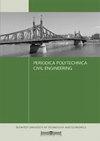Optimizing Landfill Capacity: A Numerical Study of the Slope Inclination Variation Impact on Landfill Storage Capacity and Its influence on the Safety Factors under Different Models
IF 1.4
4区 工程技术
Q3 ENGINEERING, CIVIL
引用次数: 0
Abstract
As an attempt to enhance landfill capacity and extend its lifespan, this research explores the effect of slope inclination on landfill storage capacity and its implementation on the safety factors using numerical simulations. A geometric approach was used to determine the capacity change with inclination, and a new probabilistic calculation method, which accounts for the heterogeneity of waste layers, was employed to analyze the safety factor for different slope angles. Over 100 conducted calculations for each inclination were used to investigate the effect of slope variation on landfill safety. The results show that increasing inclination leads to a significant increase in landfill capacity. The safety factor results indicate that the conventional method, assuming homogenous waste, classifies 1:3 and 1:2 slopes as safe, while the new suggested method showed that a 2:3 inclination could be considered safe, especially since the calculation is not considering the safety-enhancing effect of daily cover layers. This study highlights the importance of considering the heterogeneity of waste layers in safety factor analysis, and the use of multi-layered nonhomogeneous calculation method, which provides more flexibility in design parameters. This research presents a significant step forward in constructing safe and cost-effective landfills. The use of a new probabilistic calculation method in designing landfills leads to more accurate and reliable results while maintaining safety standards. This research has important implications for the design and management of landfills and can be used as a guide for future studies in this field.填埋场容量优化:不同模型下边坡倾角变化对填埋场库容影响及其对安全系数影响的数值研究
为了提高填埋场容量,延长填埋场寿命,本研究采用数值模拟的方法,探讨了边坡倾角对填埋场库容的影响及其实施对安全系数的影响。采用几何方法确定了承载力随倾斜度的变化规律,并采用考虑矸石层非均质性的概率计算方法分析了不同倾斜度下的安全系数。每一种倾斜度都进行了超过100次的计算,以研究坡度变化对堆填区安全的影响。结果表明,倾角增大,填埋容量显著增大。安全系数计算结果表明,在假设垃圾均质情况下,传统方法将1:3和1:2的坡度划分为安全坡度,而新方法认为坡度为2:3的坡度可以被认为是安全坡度,特别是在计算中没有考虑日覆盖层的安全加固作用。本研究强调了在安全系数分析中考虑废物层的非均质性的重要性,并采用多层非均质计算方法,使设计参数具有更大的灵活性。这项研究为建设安全和经济有效的垃圾填埋场迈出了重要的一步。在设计堆填区时,采用新的概率计算方法,可在保持安全标准的情况下,获得更准确和可靠的结果。本研究对垃圾填埋场的设计和管理具有重要意义,并可作为该领域未来研究的指导。
本文章由计算机程序翻译,如有差异,请以英文原文为准。
求助全文
约1分钟内获得全文
求助全文
来源期刊

Periodica Polytechnica-Civil Engineering
工程技术-工程:土木
CiteScore
3.40
自引率
16.70%
发文量
89
审稿时长
12 months
期刊介绍:
Periodica Polytechnica Civil Engineering is a peer reviewed scientific journal published by the Faculty of Civil Engineering of the Budapest University of Technology and Economics. It was founded in 1957. Publication frequency: quarterly.
Periodica Polytechnica Civil Engineering publishes both research and application oriented papers, in the area of civil engineering.
The main scope of the journal is to publish original research articles in the wide field of civil engineering, including geodesy and surveying, construction materials and engineering geology, photogrammetry and geoinformatics, geotechnics, structural engineering, architectural engineering, structural mechanics, highway and railway engineering, hydraulic and water resources engineering, sanitary and environmental engineering, engineering optimisation and history of civil engineering. The journal is abstracted by several international databases, see the main page.
 求助内容:
求助内容: 应助结果提醒方式:
应助结果提醒方式:


